Japanese Vertical Gardens: Serene Space Solutions
buddhaindooroutdoor.com participates in the Amazon Services LLC Associates Program, an affiliate advertising program designed to provide a means for sites to earn advertising fees by advertising and linking to Amazon.com.
More and more people are adding vertical gardens to their city homes each year. Space is becoming a big deal.
The Japanese vertical garden is getting really popular, mixing saving space with old beauty. These gardens show off the simple grace of traditional Japanese gardens. They bring a peaceful piece of nature into busy life.
You can have an indoor vertical garden Japan-style in a small apartment or in a big office entry. These gardens are a break from the city life.
Want to bring peace to your place high up or to your work area? Small Japanese garden vertical designs are perfect. They mix charm with use, turning empty walls into living art. Modern Japanese garden ideas fit well with vertical spaces.
Even beginners can create their own peaceful spot with Japanese garden ideas. You have lots of Japanese garden plants to pick from. Your DIY Japanese vertical garden will show off beauty and smartness.
City people love a bit of green in their grey places. The ideas of balance and simplicity from Japanese garden design work well up high.
This article will help you make vertical gardens that do well in tight spots. They also refresh your soul, following Japan’s deep garden history.
By looking into the vertical garden in Japan, you’ll find new ways to make your calm spot.
Japanese vertical gardens have two big roles. They are art that shows off nature. They help with health and happiness in busy cities. Now, let’s dive into this world where tradition meets peace up high.
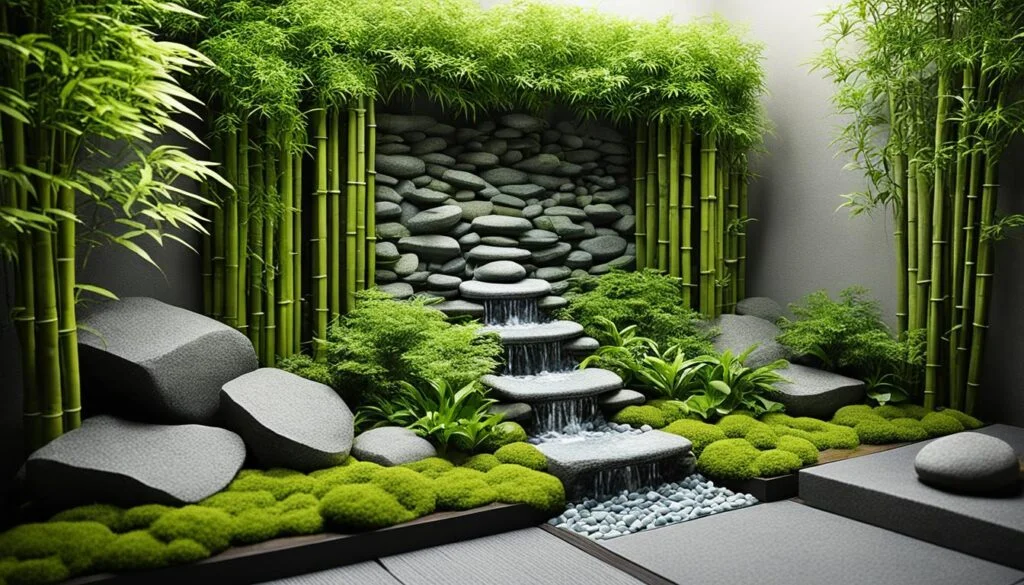
Key Takeaways
- Japanese vertical gardens integrate space-saving with the serenity of traditional Japanese garden aesthetics.
- Indoor and outdoor spaces can be transformed into peaceful sanctuaries using Japanese vertical garden techniques.
- Minimalism and natural elements like bamboo and rocks are central to modern Japanese vertical garden designs.
- DIY options allow personalization of your vertical oasis, combining authenticity with self-expression.
- Choosing the right Japanese garden plants is essential for creating a sustainable and thriving vertical garden.
Incorporating the Essence of Japanese Gardens into Vertical Spaces
The essence of Japanese gardens is pure beauty. It brings peace and balance. With tall buildings and small ground areas, the Japanese vertical garden design is a clever fix. It lets people living in cities find peace.
Think about using minimalism in Japanese gardens and how clean lines in garden design can make a peaceful spot in a vertical area.
The Role of Minimalism and Clean Lines in Japanese Vertical Garden Design
Minimalism is key in Japanese garden design. It’s about simplicity and using each part with care. In vertical gardens, minimalism is really important. It helps pick and place plants and materials to make a peaceful design. Clean lines in the design let each plant and object shine, but still work together.
Symbolism in Japanese Vertical Gardens: Cultivating Meaning Through Plant Choices
Every plant in Japanese gardens means something. It tells stories about nature and life. Think about this as you choose plants for your vertical garden.
Plants like evergreens stand for lasting life, while plants like maple show change with their colors. Your vertical garden then tells a story through nature’s symbols.
Natural Elements Fusion: Integrating Bamboo, Rocks, and Water Features
Natural elements in vertical gardens are more than just decor. They speak nature’s language. Adding bamboo shows strength and flexibility. Using rocks adds a sense of the earth’s lasting presence. Adding water features brings movement and liveliness. This contrasts with the calm of rocks and bamboo’s growth.
| Element | Symbolism | Features in Vertical Design |
|---|---|---|
| Bamboo | Flexibility and Peace | Vertical lines and green hues provide background structure |
| Rocks | Strength and Eternity | Juxtaposed sizes and shades create depth and focus |
| Water Features | Flow and Cleansing | Sound and movement introduce a tranquil and reflective mood |
Your vertical garden is more than just a space. It’s a place where features mean something big, where plants and water talk with nature. With careful planning, you can mix architecture and landscape. You can connect your living area to the soul of a Japanese garden.
Designing Your Own Japanese Vertical Garden
Creating a DIY Japanese vertical garden brings peace and beauty to your space. It turns a plain wall into a lush area that calms the mind. With some creativity and the right tips, you can make a green wall that looks like a beautiful Japanese garden.
DIY Tips for Crafting Serene Green Walls
Start by planning your garden’s layout. Use Japanese design principles like minimalism, clean lines, and element balance. Choose a structure that holds different plants well, fostering growth. Use bamboo or cedar for authenticity, and combine planters and climbers for variety.
Selecting Suitable Plants for Your Japanese Garden Aesthetic
Choose plants that bring peace and reflect the simple beauty of nature. For a Japanese garden, pick plants with different looks but a unified theme. Conifers, maples, and moss are ideal. Make sure to consider how they’ll grow over time to keep your garden beautiful and under control.
| Plant Type | Japanese Garden Role | Care Level |
|---|---|---|
| Moss | Ground cover; Symbolizes tranquility | Low maintenance; Prefers shade and moisture |
| Bamboo | Vertical accent; Represents growth and flexibility | Moderate maintenance; Requires control for spread |
| Mugo Pine | Structural form; Evokes mountainous terrain | Low maintenance; Tolerates a range of conditions |
| Japanese Maple | Focal point; Showcases seasonal color | Moderate maintenance; Needs protection from harsh sun |
As you build your DIY Japanese vertical garden, practice patience and mindfulness. Let each part, from the base to the plants, work together. This way, you’ll create a peaceful space you can enjoy every day.
Understanding the Zen Philosophy in Japanese Vertical Gardens
To make your vertical garden a place for calm and deep thought, Zen philosophy in Japanese gardens is key. Its core lies in being simple, natural, and stark, aiming to bring peace. With these ideas, your garden becomes more than just pretty—it reflects Zen ideas.
Zen principles in vertical gardens stress on the importance of each part. Every rock and plant is thoughtfully chosen to encourage peace and quiet. It avoids crowding, choosing impactful elements instead. This careful setup creates balance, connecting us to nature and ourselves.
| Zen Principle | Application in Vertical Gardens | Impact on Tranquility |
|---|---|---|
| Simplicity (Kanso) | Opt for minimal plant varieties and simple structures. | Reduces visual clutter, promoting peaceful contemplation. |
| Naturalness (Shizen) | Use organic, flowing patterns and avoid artificial symmetry. | Encourages authenticity and a sense of oneness with nature. |
| Austerity (Koko) | Embrace the beauty of empty space, termed ‘Ma’. | Highlights the beauty of what is present and fosters inner calm. |
| Subtlety (Yugen) | Incorporate elements that suggest more than they reveal. | Invites deeper thought and appreciation for the unseen. |
| Impermanence (Mujo) | Choose plants that change with seasons. | Reflects life’s transient nature, evoking a sense of serenity. |
Zen practice encourages us to pay attention to every detail. It’s not just for looks; it’s about making a mindful, peaceful place. Your vertical garden shows your commitment to calm, wise living, just as Zen philosophy in Japanese gardens suggests.
The Karesansui, or dry landscape garden, is pure tranquility in Japanese garden design. It uses gravel, rocks, and minimal plants. Though it’s hard to do vertically, you can still use its ideas. Think about using textures and simple colors to create a calm feeling.
So, every choice in your garden must be meaningful. It’s like a mirror of life—each step should have purpose and be full of intent.
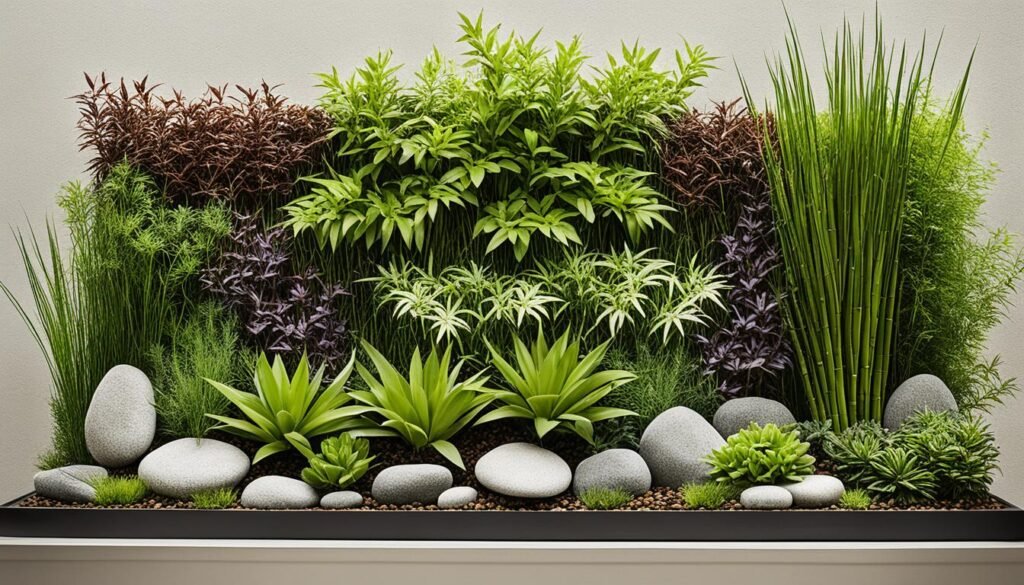
Embedding Zen into your garden is a journey of change and growth. Each update is a chance to deepen its Zen character. Let your garden blend the tangible with the philosophical, making a peaceful haven for all.
Maximizing Small Spaces with Japanese Vertical Garden Techniques
Japanese vertical garden techniques are great for small spaces. They combine beauty and efficiency perfectly. By using maximizing small spaces with vertical gardens, tiny areas can become lush, green places. These methods make it easy to bring tranquility and harmony into your home or office, even if space is tight.
Creating Tranquility in Compact Areas Using Vertical Elements
Using vertical elements is key to creating tranquility in compact areas. You can use wall-mounted planters, hanging pots, and trellises. These let plants grow upwards, making spaces feel larger and more peaceful. It’s like having a piece of nature inside. Plus, it fits well with the simple yet beautiful Japanese design.
Strategies for Implementing Japanese Garden Principles in Restricted Spaces
Strategies for implementing Japanese garden principles in restricted spaces need careful planning. Japanese gardens focus on balance, harmony, and simplicity.
You can bring these qualities to small vertical gardens by choosing the right plants and layout. It’s important to pick plants that thrive vertically and reflect the essence of Japanese gardens.
| Plant Type | Characteristics | Suitability for Small Spaces |
|---|---|---|
| Bamboo | Fast-growing, elegant, and evergreen | Excellent for creating height and structure |
| Moss | Soft texture, shade-tolerant, and low-growing | Ideal for covering soil and creating a lush look |
| Ferns | Lush foliage, varies in size and form | Perfect for adding greenery in compact spaces |
| Mounding Plants | Rounded habit, symbolizes islands | Great for recreating traditional Japanese garden islands |
These vertical garden techniques let you bring Japanese serenity into your space. They make it possible to have peace, balance, and beauty in even the smallest spots. Your home or office can feel more uplifting, all thanks to these ideas.
Combining Function with Beauty: Practical Tips for Japanese Garden Planning
In Japanese garden planning, blending function and beauty is key. This approach makes gardens both captivating and useful.
For those passionate about Japanese garden planning, clear strategies exist. They ensure each element adds to a peaceful and practical space. Imagine how a simple tea house can be both a central feature and a cozy hideaway, perfectly showing this balance.
Looking at the function of garden features becomes easy when matched with Japanese design’s calm aesthetics.
Features like bridges, stepping stones, or lanterns do more than catch the eye; they help people move and light the way. This mindful blend underscores the value of combining function and beauty in garden design.
Harmonizing Your Outdoor Decor with Functional Garden Structures
Start by thinking about how each garden structure can have two uses. For example, functional garden structures such as bamboo fencing offer privacy and honor traditional Japanese materials. A well-placed stone bench offers a spot for thought, serving as both artwork and a resting place to enjoy your garden.
The skill of harmonizing outdoor decor involves choosing elements that mirror the natural world. Pergolas covered in wisteria or roses provide shade and beauty, blending human creativity with nature’s charm.
Choosing the Right Materials for Durability and Authenticity
For a garden to feel authentic, choosing materials that last is essential. Stone, bamboo, and cedar wood withstand the elements and age well. This durability helps every part of your garden, from water basins to gates, remain important and beautiful over time.
When picking materials, think about their history and use in Japanese gardens. Choosing durable materials for Japanese gardens means more than just weathering the elements. It’s about keeping a piece of cultural heritage alive. Look for suppliers known for genuine materials, keeping your garden true to its roots.
| Material | Benefits | Typical Use |
|---|---|---|
| Bamboo | Flexible, strong, renewable | Fencing, water spouts, frames |
| Stone | Durable, natural, versatile | Pathways, lanterns, basins |
| Cedar Wood | Resistant to decay, aromatic | Bridges, gates, buildings |
| Moss | Soft texture, low maintenance | Ground cover, accents |
In conclusion, choosing the right stones or building a tea house involves careful thought. Following practical tips for Japanese garden planning ensures every detail looks great and lasts long. This way, your garden stays a place of calm and beauty through every season.
Embracing Seasonal Beauty in Your Japanese Vertical Garden
Japanese vertical gardens celebrate nature’s cycles, showing the beautiful change over time. They let you make a living artwork that’s beautiful all year. These gardens feature Sakura blossoms in spring and Maple trees in fall, among other plants.
Selecting Seasonal Flora to Enhance Year-Round Enjoyment
Design a Japanese vertical garden with the seasons in mind for a lively and inviting space. You’ll enjoy vibrant spring colors, the lush summer, warm fall tones, and winter’s calm. Choosing plants that do well in different seasons adds beauty and practicality to your garden.
Capturing the Evanescent Charm of Sakura and Maple Trees Vertically
The brief beauty of Sakura and the lasting charm of Maple leaves are central to Japanese gardens. Even vertically, these trees, through smart choices and pruning, can shine.
Sakura trees show off pink and white blooms, symbolizing life’s short nature. Meanwhile, Maple trees announce fall with their red and orange leaves.
| Season | Flora | Visual Feature | Sensory Appeal |
|---|---|---|---|
| Spring | Sakura (Cherry Blossoms) | Pink and White Canopy | Sweet Fragrance |
| Summer | Japanese Iris, Hydrangea | Bright Blooms | Lush Greenery |
| Autumn | Japanese Maple | Fiery Red Leaves | Rustling Foliage |
| Winter | Pine, Bamboo | Evergreen Presence | Sturdy Structure |
Integrate these seasonal wonders into your vertical garden to honor Japanese garden traditions. This not only pays respect to a long history but also makes a personal sanctuary. It reflects nature’s ongoing cycle.
Japanese Garden Plants: Selecting Varieties for a Vertical Oasis
Creating a vertical oasis with Japanese garden plants makes your space a peaceful retreat. It reflects the timeless beauty of Japanese design. When picking plants, it’s key to find a balance in shape, texture, and health for your garden.
Bonsai, Ferns, and Moss: Perfect Plants for Japanese Vertical Greenery
Bonsai in Japanese gardens are special because of their intricate shapes and small size. They bring a unique touch to your vertical garden. Bonsai need careful trimming and upkeep to grow well.
Adding ferns in Japanese gardens brings in a soft, lush texture. This contrasts well with the bonsai. Also, moss in Japanese gardens covers the ground in bright green and adds calm, much like traditional Japanese landscapes. Imagine your vertical garden as art. Pick plants that look good together in size, shape, and color.
How to Ensure Plant Health in a Vertical Setting
To keep plant health in vertical settings good, you must know what each plant needs. Bonsai need soil that drains well and regular feeding. Ferns love moist, shady spots in your vertical garden. Moss is easy to care for, needing just the right amount of moisture to stay green.
Let’s look at how to take care of these plants successfully.
| Plant Type | Watering Needs | Light Requirements | Soil Preferences | Maintenance Tips |
|---|---|---|---|---|
| Bonsai | Schedule water when the soil feels dry | Bright, indirect light | Well-draining with grit or pebble | Regular pruning and reshaping |
| Ferns | Keep consistently moist, never waterlogged | Partial shade, no direct sunlight | Loose, rich, and well-aerated | Humidity is key, mist leaves regularly |
| Moss | Water to maintain moisture, not wetness | Shade to partial sunlight | Acidic soil that retains water well | Trimming isn’t necessary; remove debris |
If you follow these guidelines, your vertical garden will flourish. It will become a peaceful, vibrant place. Watch how your plants react to your care. This will help you make the best home for them. Enjoy creating your own piece of nature. The beauty it adds is truly rewarding.
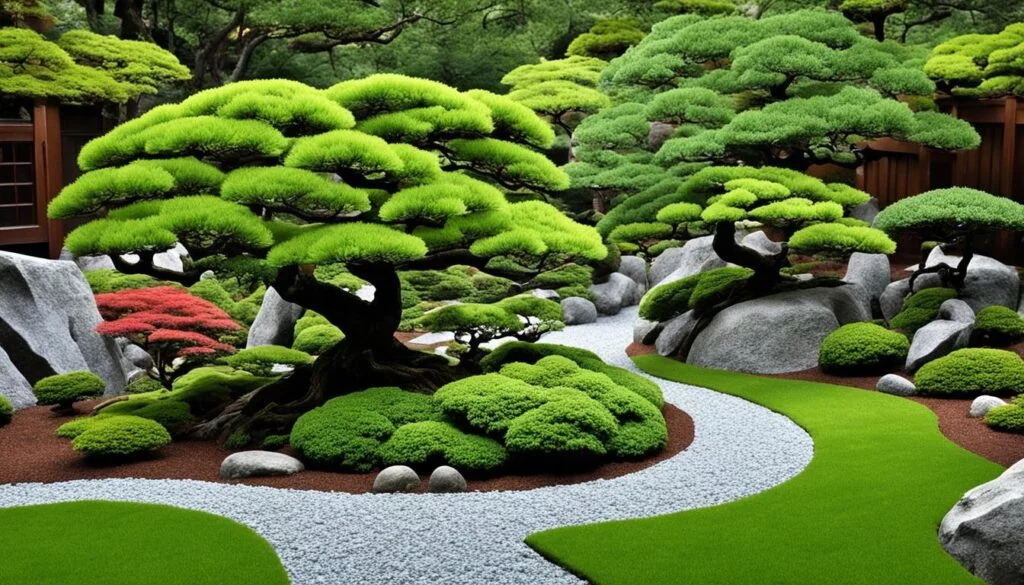
By carefully choosing and caring for Japanese garden plants, your vertical oasis will not just live but flourish. It will be a place of calm every day. This shows the beautiful balance of nature’s work.
Water Features in Japanese Vertical Gardens: A Symbolic Approach
Adding water features in Japanese gardens does more than look good. It holds deep meanings, showing the value of life and change in the landscape.
By adding these to vertical gardens, you get both beauty and the calming sound of water. This boosts the area’s calmness. The symbolism of water in Japanese gardens stands for cleanliness, new beginnings, and the endless march of life. This adds a deep calm to the vertical landscape.
Want to bring this calming element to your vertical garden? Think about adding water features that blend in well and match the traditional Japanese garden’s symbolic design.
Small waterfalls, wall fountains, and reflective materials can all add a meditative feel to your garden spot. When you add water features to vertical gardens, strike a balance with the plants around to keep things looking natural.
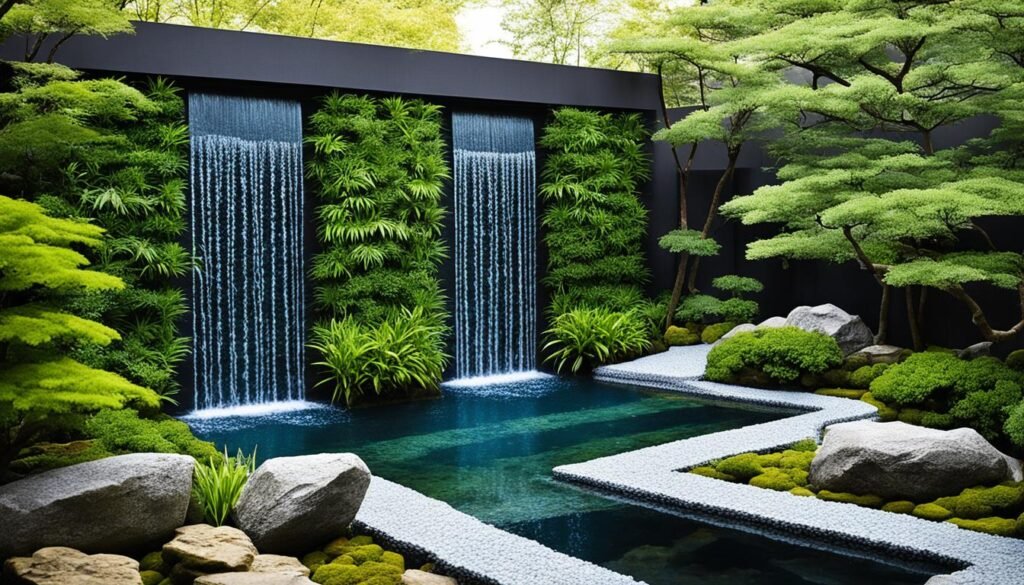
Here are some ways to bring water features into vertical gardens, helping you feel closer to nature:
- A small waterfall over moss and ferns
- A wall fountain inspired by zen
- A hidden mist system to mimic the dampness of a Japanese forest
Thoughtfully including water features lets you bring the spirit of a Japanese garden into tight vertical spaces. The sound of water adds to a full sensory experience, rich with meaning and symbolism.
| Feature | Symbolism | Vertical Garden Application |
|---|---|---|
| Mini Waterfall | Continuous movement, flow of energy | Compact and can fit into small vertical gardens |
| Wall-mounted Fountain | Calmness and introspection | Ideal for creating a focal point |
| Misting System | Clouds and mist, connection to the heavens | Provides moisture and creates a refreshing ambiance |
Let the dynamic yet deep nature of water in your vertical garden bring a soothing touch. Its calming effect and symbolism will make your space a peaceful retreat.
Guiding Flow and Energy: Pathways and Stream-lets in Vertical Gardens
Turn your vertical gardens into a peaceful spot by embracing the guiding flow and energy in Japanese gardens. This design captures the senses by guiding your vision through a mix of textures and hues.
Pathways in vertical gardens lead your eye in this living art, while stream-lets in vertical gardens bring movement, like water’s gentle flow, to the quiet space around them.
Incorporating Gravel and Stone for Authentic Pathways Up High
Adding gravel and stone keeps your vertical gardens looking classic and rich in textures. These elements carve paths that wander up the wall, showing a journey through nature. Their feel and look invite you to stop, inspect closely, and feel connected to Earth, even from up high.
Design Techniques for Creating the Illusion of Water in Vertical Gardens
To mimic a flowing stream without water, get creative with your vertical garden designs. Use shiny materials, wave-like plants, or even glass and mirrors arranged smartly to copy water’s shimmer. Below is a table with ideas to capture the serene vibe of water, without any water needed.
| Element | Illusion Technique | Visual Impact |
|---|---|---|
| Mirrors | Placement at angles to reflect light | Creates a sense of water depth and movement |
| Blue Glass | Chipped or tumbled for a water-like texture | Imitates water’s sparkle and hue |
| Silver Foliage Plants | Grouped to mimic ripples | Suggests fluidity and flow |
| Gravel Stream-beds | Indented and curved paths filled with fine gravel | Simulates dry stream-lets |
Traditional Elements in Modern Japanese Vertical Garden Designs
Garden lovers are blending old and new in Japanese gardens today. This mix boosts both the garden’s look and its health and sustainability. Let’s explore how old ideas are refreshed with modern methods and tech.
Fusing Contemporary Designs with Traditional Japanese Garden Techniques
Modern Japanese garden art skillfully combines old and new gardening techniques. Clean lines and simple structures meet the peaceful, organized feel of classic Japanese gardens. This blend honors tradition while keeping up with today’s styles.
Integrating Technological Advances for Garden Health and Sustainability
Technology brings a fresh layer to garden design, increasing both ease and the garden’s well-being. Smart irrigation systems give plants exactly what they need, cutting down on waste. Plus, energy-saving lights follow natural light patterns, aiding plant growth. Smart sensors keep an eye on soil health, helping your garden flourish.
Conclusion
In concluding our journey through Japanese vertical garden methods, we’ve explored how these gardens combine calmness with smart use of space. This exploration helps create an area that blends traditional Japanese garden peace with modern vertical designs.
It’s about more than just making your garden look good. It’s about building a peaceful spot that values simplicity, meaningful symbols, and bringing nature into everyday life.
Think about how Japanese garden techniques can transform spaces. They fit well whether you live in a busy city or a wide-open suburb. By adopting these ideas, your garden becomes a peaceful retreat in every corner.
As the seasons change, your garden will unveil new layers of beauty. This invites you to stop and reflect on life’s fleeting moments, surrounded by the right plants and beautiful water elements.
By creating a vertical garden inspired by Japanese style, you’re adding to a tradition that combines old beauty with new ideas. With thoughtful planning, nature’s calmness is brought up to your level, making a special spot for you.
In this serene place, each part works together to foster an atmosphere of peace and growth. It’s a beautiful end to the skill and craft of making Japanese gardens.
Source Links
- https://tamatelandscaping.com/japanese-garden-elements-for-a-serene-oasis/
- https://mojoboutique.com/blogs/blog/japandi-terrace-ideas
- https://www.marshalls.co.uk/gardens-and-driveways/blog/japanese-garden-ideas

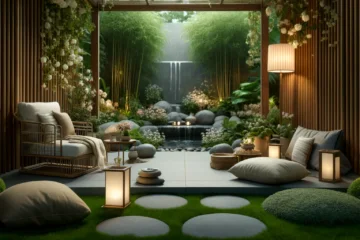
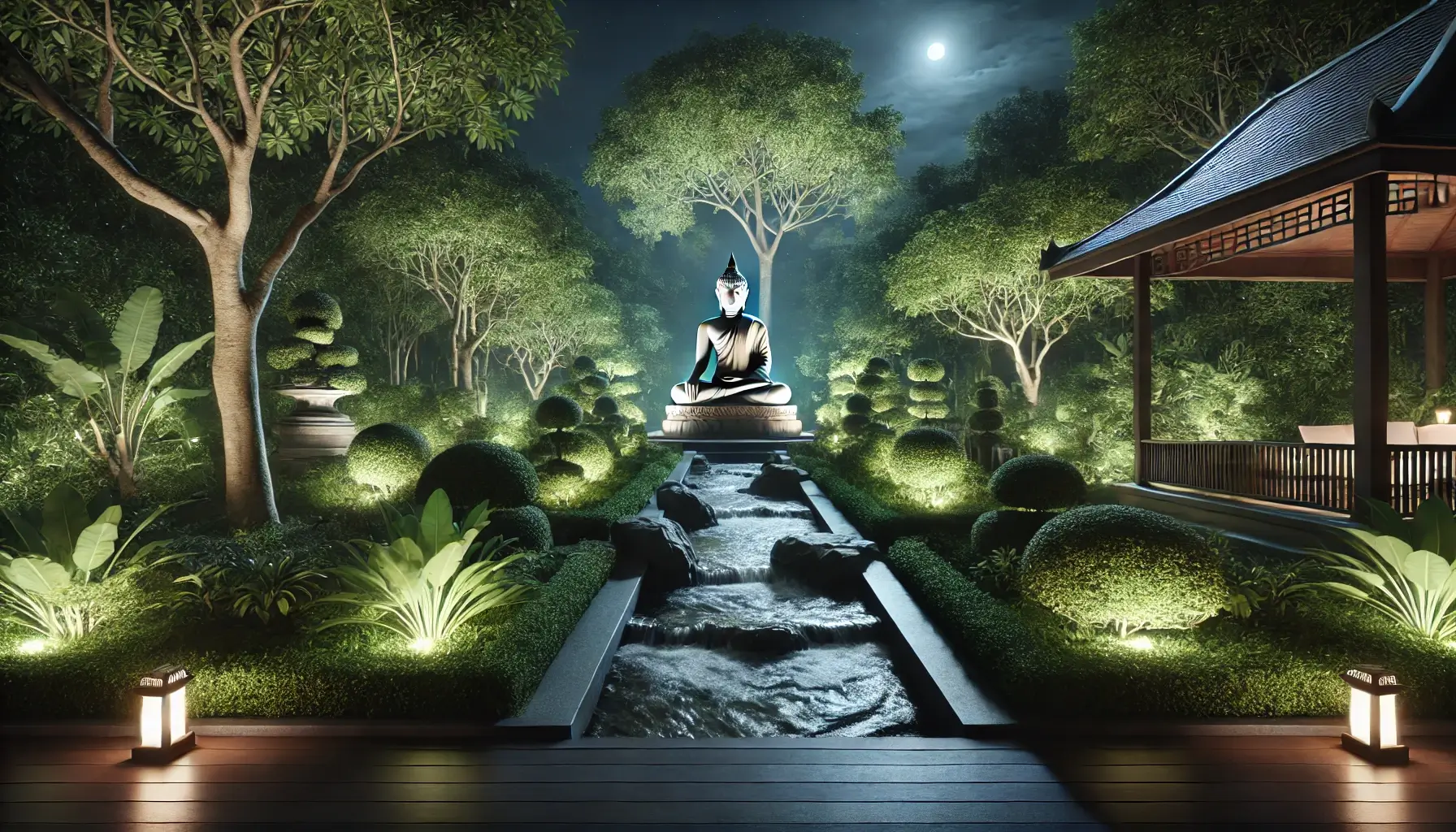
0 Comments